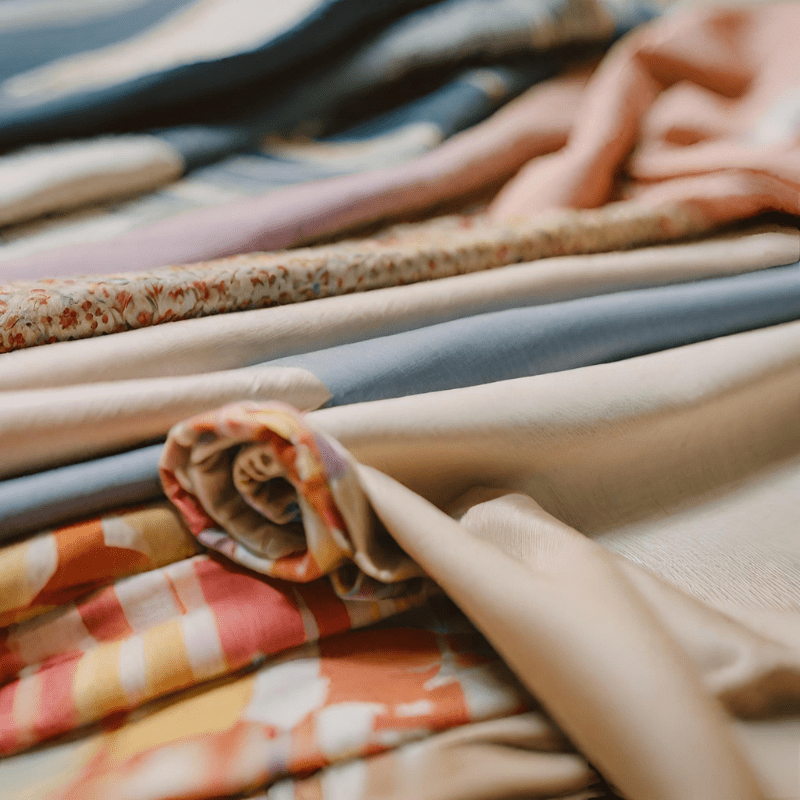Fabric 101 for Designers: Understanding the Basics
Written by DoraFashion
In This “Fabrics 101 For Designers” Series, We Embark On A Journey Through The Diverse Realm Of Textiles, Uncovering Their Unique Characteristics And Unraveling Their Potential. From The Luxurious Embrace Of Silks To The Dependable Structure Of Denim, Each Fabric Tells A Story And Holds The Promise Of Transforming A Mere Design Into A Masterpiece.


In the world of fashion design, fabric selection is akin to an artist’s choice of canvas. It lays the foundation for every stitch, fold, and contour, shaping the very essence of a garment. Understanding fabrics is not just a skill; it’s an art.





The Comprehensive Guide to Fabrics: Composites, Structures, and Textures.
Fabric Types by Composites:
Natural Fabrics:
Natural fabrics are derived from materials found in nature, such as plants (cotton, linen), animals (wool, silk), and minerals (asbestos).
- Cotton: Known for its breathability and versatility, cotton is a staple in many wardrobes. It’s comfortable, easy to care for, and widely used in various types of clothing.
- Source: Derived from the cotton plant’s fibers.
- Characteristics: Highly breathable, absorbent, soft, and comfortable. Suitable for a wide range of garments, especially in warm climates.
- Examples: T-shirts, dresses, bed linens.
- Wool: A natural insulator, wool is prized for its warmth. It’s commonly used in winter wear and provides excellent moisture-wicking properties.
- Source: Obtained from the fleece of sheep or other animals like goats.
- Characteristics: Insulating, warm, and resilient. Comes in various forms from fine merino to coarse tweed.
- Examples: Sweaters, coats, blankets.
- Linen:
- Source: Made from the flax plant’s fibers.
- Characteristics: Highly breathable, lightweight, and known for its natural texture. Ideal for warm-weather clothing.
- Examples: Shirts, trousers, tablecloths.
- Silk: Luxuriously smooth and soft, silk is synonymous with elegance. It’s a fine, delicate fabric often used for special occasions.
- Source: Produced by silkworms to form their cocoons.
- Characteristics: Luxurious, smooth, and lightweight. Known for its shimmering appearance. Often used in formal and high-end fashion.
- Examples: Evening gowns, scarves, ties.
- Cotton: Known for its breathability and versatility, cotton is a staple in many wardrobes. It’s comfortable, easy to care for, and widely used in various types of clothing.
Blends Fabrics:
- Blends combine different types of fibers, leveraging the strengths of each to create a fabric with enhanced properties.
- Cotton-Polyester Blend: Combining the breathability of cotton with the durability of polyester, this blend is widely used in casual wear and activewear.
- Wool-Synthetic Blend: This blend offers the warmth of wool with added durability and moisture-wicking properties from synthetic fibers.
- Blends combine different types of fibers, leveraging the strengths of each to create a fabric with enhanced properties.
Synthetic Fabrics:
Synthetic fabrics are man-made and created through chemical processes. They often offer specific performance features like durability, stretch, and moisture-wicking properties.
- Polyester: Resistant to wrinkles and shrinking, polyester is a durable synthetic fabric commonly used in activewear, outerwear, and blends with other fabrics.
- Nylon: Known for its strength and resilience, nylon is often used in hosiery, swimwear, and outdoor gear due to its quick-drying properties.
- Spandex (Lycra): Renowned for its elasticity, spandex is blended with other fabrics to provide stretch and recovery, making it essential in sportswear.
Semi-Synthetic Fabrics:
Semi-synthetic fabrics, also known as regenerated or man-made cellulosic fibers, are produced from natural raw materials, primarily plant-based cellulose.
Viscose/Rayon:
- Source: Derived from wood pulp or bamboo.
- Characteristics: Soft, breathable, and drapes well. It mimics the look and feel of natural fibers like cotton or silk.
- Common Uses: Blouses, dresses, linings, and summer clothing.
Modal:
- Source: Made from beech tree pulp.
- Characteristics: Similar to viscose but with added strength and moisture-wicking properties.
- Common Uses: Activewear, underwear, and casual wear.
Lyocell (Tencel):
- Source: Produced from wood pulp, often eucalyptus trees.
- Characteristics: Soft, breathable, and environmentally friendly due to its closed-loop production process.
- Common Uses: Clothing, bedding, and home textiles.
Acetate:
- Source: Derived from wood pulp or cotton linters.
- Characteristics: Lustrous, lightweight, and often used as a silk substitute.
- Common Uses: Lining material, eveningwear, and lingerie.
Cupro:
- Source: Made from cotton linters, the short fibers that stick to cotton seeds.
- Characteristics: Similar to silk in texture, breathable, and moisture-wicking.
- Common Uses: Blouses, dresses, and linings.
Fabric Types by Structures in a Nutshell
Fabrics are categorized based on their weaving or knitting patterns, defining their structure. Understanding these structures is crucial in selecting the right fabric for specific garment applications.
Woven Fabrics:
Woven fabrics are created by interlacing warp (lengthwise) and weft (crosswise) yarns at right angles. They tend to be more stable and less stretchy compared to knitted fabrics. Examples include cotton, denim, and twill.
Knitted Fabrics:
Knitted fabrics are made by interlocking loops of yarn. They have natural stretchiness and are often used in garments that require flexibility. Common examples include jersey, rib-knit, and interlock.
Fabric Types by Textures in a Nutshell:
Smooth Textures:
- Satin
- Charmeuse
- Silk
- Chiffon
- Organza
Nubby Textures:
- Tweed
- Bouclé
- Raw Silk
- Slub Cotton
Ribbed Textures:
- Corduroy
- Ottoman
- Grosgrain
- Rib Knit
Crisp Textures:
- Poplin
- Taffeta
- Organdy
- Lawn
Soft Textures:
- Jersey
- Modal
- Cashmere
- Velvet
- Rough Textures:
- Burlap
- Denim
- Canvas
- Tweed
- Crepey Textures:
- Crepe
- Georgette
- Crinkled Chiffon
- Fuzzy Textures:
- Faux Fur
- Mohair
- Chenille
- Knit Textures:
- Jersey Knit
- Interlock Knit
- Rib Knit
- Mesh and Net Textures:
- Fishnet
- Tulle
- Mesh


Fabric 101 for Designers: Understanding of Textures
Next Up!
Selecting the right fabric texture is an art in itself, one that can truly elevate your designs. The tactile sensation of a garment speaks volumes about its quality and aesthetic appeal. In this guide, we’ll dive into the fascinating world of fabric textures, unraveling their significance and providing insights into their various forms. Remember, textures emerge from the interplay of fabric structures and composites, giving rise to a spectrum of options. Join us on this exploration as we introduce you to ten fundamental fabric textures, each offering a unique touch and visual character. Let’s embark on this journey of tactile creativity together.
Categories
Dora Fashion
Fabrics
Manufacturing
Fashion Design
Marketing & Branding
Related Articles
Related
Fashion Design 101: The Color Theory and Color Influencers
Color Theory In Fashion Design Revolves Around Understanding How Colors Interact, Complement, Or Contrast To Evoke Emotions And Convey Messages Through Clothing. It Encompasses The Color Wheel, Harmonies, Contrasts, And Their Psychological Effects. This Knowledge...
Fabric 101 for Designers: How to Select Your Fabrics
Embark on a journey into the heart of fabric selection with our comprehensive guide. From understanding the unique characteristics of each fabric type to exploring their diverse textures, drapes, and movements, this guide is your passport to crafting exceptional...
Fabric 101 for Designers: How to Understand the Textures
Selecting the right fabric texture is an art in itself, one that can truly elevate your designs. The tactile sensation of a garment speaks volumes about its quality and aesthetic appeal. In this guide, we'll dive into the fascinating world of fabric textures,...

